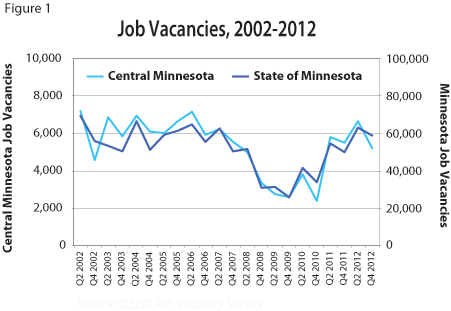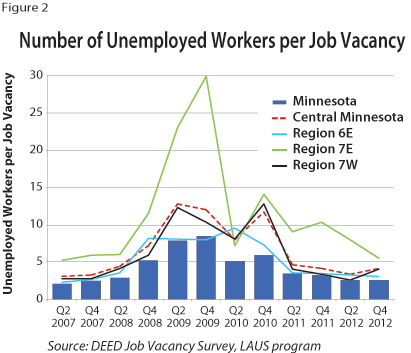
by Cameron Macht
June 2013
After a difficult recession, jobs are coming back in central Minnesota, especially in the retail trade and the accommodation and food services sectors.
After a couple years of bad news, central Minnesota's economy is finally experiencing some good news. The region's annual unemployment rate shrank to 6.3 percent in 2012, finishing within 0.7 percent of the state jobless rate. That was an improvement from the peak of the recession in 2009, when the region's unemployment rate was nearly 1.5 percent higher than the state jobless rate.
Unemployment rates dropped in all 13 counties in the region in the last year and actually fell faster in nine of those counties than in the state overall. Eleven of the 13 counties, however, still had higher rates than the state, including three of the six-highest annual unemployment rates in the state.
Employment, meanwhile, went up in 11 of the 13 counties over the last year, with more than half of the counties adding jobs faster than the state. Central Minnesota gained nearly 3,600 jobs in the last year, a 1.4 percent increase that was slightly faster than the state as a whole. Total employment is not back to 2007 levels yet, but another year of solid job growth should get it close.
Job vacancies reported by businesses in the region have returned to pre-recessionary levels in the last two years. After averaging more than 6,000 job vacancies from 2002 to 2006, central Minnesota employers pulled back on hiring activity from 2007 through 2010. At the height of the recession in 2009, job vacancies fell to their lowest levels on record, forcing job seekers to struggle through a stagnant job market.
Then central Minnesota employers reported a major year-over-year increase in job vacancies from 2010 to 2011, with openings climbing back to nearly 6,000 in the second quarter of 2011. The 6,657 job vacancies reported in the second quarter of 2012 was the first time the region surpassed 6,000 vacancies since 2007 (see Figure 1).

Several of the industries hit hardest by the recession saw the strongest return in job vacancies in the last two years. As consumers cut back on spending, the retail trade and the accommodation and food services sectors cut back on hiring, reporting 60 percent fewer vacancies in the fourth quarter of 2010 than in the fourth quarter of 2007. Then the number of job vacancies in retail trade and accommodation and food services tripled from 2010 to 2012. Sixty percent of manufacturing job vacancies also disappeared during the recession, before returning in force in 2011 and 2012 (see Table 1).
| Central Minnesota Job Vacancy Survey Statistics, 2007-2012 | ||||||
|---|---|---|---|---|---|---|
| Q4 2007 | Q4 2008 | Q4 2009 | Q4 2010 | Q4 2011 | Q4 2012 | |
| Manufacturing | 477 | 310 | 187 | 334 | 467 | 442 |
| Retail Trade | 807 | 261 | 398 | 256 | 1,059 | 702 |
| Health Care and Social Assistance | 1,411 | 690 | 501 | 536 | 1,045 | 880 |
| Accommodation and Food Services | 512 | 636 | 314 | 277 | 938 | 907 |
| Total, All Industries | 5,534 | 3,343 | 2,580 | 2,394 | 5,526 | 5,220 |
| Source: DEED Job Vacancy Survey | ||||||
Although health care and social assistance didn't see job declines like manufacturing or retail trade experienced, hiring activity did slow during the recession. Job vacancies actually fell faster in health care and social assistance than any other industry from 2007 to 2009, though health care also bounced back in the last two years.
With just under 22,000 unemployed workers in the fourth quarter of 2012, central Minnesota averaged 4.2 job seekers for every vacancy. While that number is still high, it was a significant improvement from 2009, when the region averaged about 12 job seekers per vacancy (see Figure 2).

At the peak, there were almost 30 unemployed workers for every job vacancy in Region 7E (Chisago, Isanti, Kanabec, Mille Lacs and Pine counties). The four counties in Region 7W (Benton, Sherburne, Stearns and Wright counties) also tended to have a much higher number of job seekers than vacancies. Meanwhile, Region 6E (Kandiyohi, McLeod, Meeker and Renville counties) tracked the state rate more closely, with 2.6 unemployed workers for each vacancy in the fourth quarter of 2012.
For unemployed workers in the region, the competition for available jobs can be fierce. But for employers in central Minnesota that are actively hiring again, large numbers of job seekers have allowed them to get back up to speed quickly.